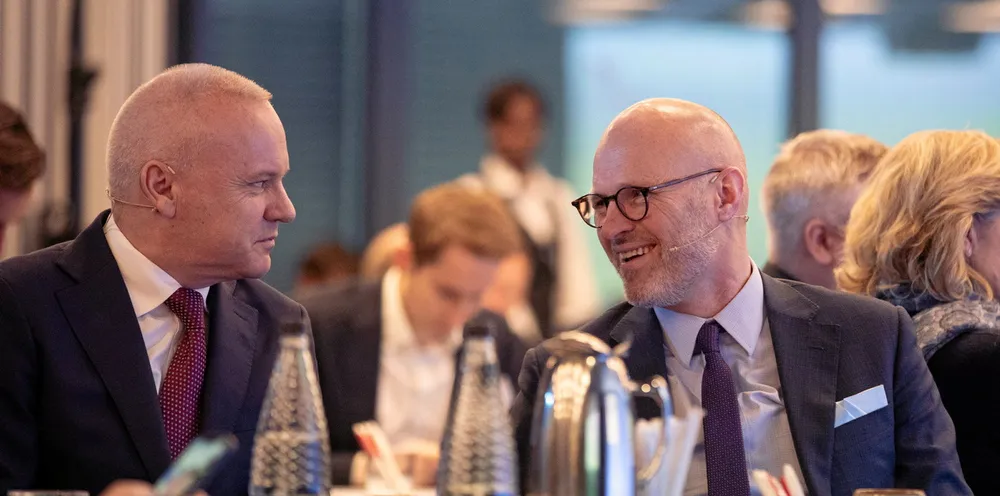'High-grading' Equinor grilled over spend and return for Empire Wind
Norwegian group's chiefs insist they have found the best way to 'restore commerciality' to the US project

Equinor has allocated $2.7bn to develop New York’s 2GW Empire Wind arrays in 2024-25, prompting close scrutiny from financial analysts about future returns from the troubled project.
Empire Wind 1&2 and the 2.4GW Beacon Wind 1&2 projects were to have been jointly developed under a 50-50 partnership between Equinor and BP.
The two companies tried, unsuccessfully to convince New York state authorities to adjust the terms of offtake agreements, becoming the latest US offshore wind venture to be blown off course by worsening economics.
Equinor provided more information about the transaction in its capital markets update, held in London on Wednesday.
'High-grading'
The oil giant said it had consolidated Empire Wind into its financial accounts, with capital expenditure on the project set at $1.2bn in 2024, out of an annual total $13bn for 2024.
Another $1.5bn is earmarked for Empire Wind in 2025.
Continued development of Empire Wind is likely to depend on Equinor achieving a positive result in the fourth bid round in New York, after re-submitting the 806MW Empire Wind 1 for new terms.
The 1.2GW Empire Wind 2 is “being matured for future solicitation rounds”, according to Equinor.
Equinor’s guidance suggested a return on capital of 4% for Empire Wind, at the bottom of the company’s promised range of 4-8% for unlevered return on renewables investments.
“Keep in mind that, for the Empire Wind project, we intend to use project financing and we aim to farm down at the right time. And this would lead to reduction in capex,” Equinor’s CFO Torgrim Reitan told analysts. “We will transition and grow while maintaining profitability.”
Equinor described its latest moves on US assets as “high-grading” its offshore wind portfolio and “restoring commerciality to Empire Wind”.
Reitan said the decision to submit a bid for New York 4 was “the solution creating most value which along with the planned project financing and farm-down, would reduce exposure and increase returns.”
Volume or value?
Capital allocation for Empire Wind was nonetheless questioned by analysts who had been told to expect a value-orientated approach to investments.
“To be very clear, value over volume is still our guidance, both for oil and gas and also for renewables," CEO Anders Opedal responded.
“Moving forward with Empire after the deal we did with BP is what we see is creating the best value for Equinor. We are within the guidance …. if we take into account the recent transactions we have done there. Now we're waiting for the results from the bid,” he said.
Opedal added: “We will, at the right time, find another partner and we will project finance this.
CFO Reitan added that Equinor aims to follow a de-risking process that starts with a successful bid on New York 4, goes through a final investment decision and concludes with a project finance package expected to be in place “late this year”.
Equinor’s executives also underlined efforts to extract more value by increasing the life cycle of offshore wind farms.
Dogger boost
In the case of its Dogger Bank invesment in the UK, which Equinor says achieves nominal equity returns between 12% and 16%, the company's head of technology, digital and innovation Hege Skryseth described the use of new digital solutions for operation and maintenance
“These solutions are currently not available in the market. This will extend lifetime from 25 to 35 years, allowing us to increase revenues in the merchant period, reduce operational costs and increase efficiency,” she stated.
Opedal said the same approach to creating value “over time” will be applied to Empire Wind. “This is the best way we can create value from the Empire project in our mind,” he said.
As a mature project with “four years of permitting work behind it” and with its main contracts secured with negotiated rates, Empire Wind will be in a good position to attract project financing and farm-down proposals, according to Equinor’s vice-president for renewables Pal Eitrheim.
“We have a fairly good line of sight to what the cost level will be. So I'm quite hopeful that we will be able to find a good partner and that this is an attractive asset also because it is among the few that can develop in a sort of pre-2030 perspective,” he added.
Equinor’s guidance states that the company expects an unlevered return on equity ranging from 4% to 8%, but Opedal said the company’s renewables portfolio from 2015 to 2023 shows double-digit return.
“We would have liked to see better returns (on Empire Wind) and we are sure that we are going to create some additional returns from that project as we go. Beyond that in the project portfolio, there is actually a healthy return in the offshore wind portfolio,” Reitam added.
Pal Eitrheim acknowledged that Empire Wind and Beacon Wind had faced major challenges last year as “unprecedented” inflation eroding profitability.
Equinor’s strategic aims for renewables includes 12-16GW of installed capacity by 2030 and delivery above 65 terawatt hours of renewable power by 2035.
Equinor’s guidance suggested its capital expenditure will average between $14bn and $15bn from 2025 to 2027.
(Copyright)